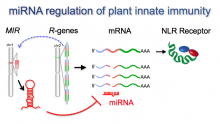Plant innate immunity depends on recognition of pathogen effectors and triggering of host defenses. Major classes of innate immune receptors, the nucleotide binding-leucine rich repeat receptors (NLRs) and leucine rich repeat (LRR) receptors are encoded by large families of resistance (R)-genes. NLR and LRRs are activated by recognition of specific pathogen effectors and once activated they trigger the hypersensitive cell-death response. While multiple NLRs and LRRs protect plants from diverse pathogens their inherent cell death activity and the large number of encoding R-genes in plant genomes require strict regulation. We developed the SoMART server to identify and predict the function of miRNAs and siRNAs in Solanaceae.
require strict regulation. We developed the SoMART server to identify and predict the function of miRNAs and siRNAs in Solanaceae.
Plant microRNAs (miRNAs) and small interfering RNAs (siRNAs) guide sequence-specific silencing of genes, repetitive DNA and viruses through Watson-Crick base pairing and play essential regulatory roles in development, genome function and host defense.
We discovered novel miRNA families whose members silence R-gene encoding NLRs and LRRs including those that confer resistance to the major pathogens of Solanaceae crops. Many of these novel miRNAs belong to a structurally and functionally unique class of 22-nt miRNAs and amplify silencing by triggering the production of secondary trans-acting siRNAs (tasiRNAs) from cleaved transcripts. The lab further showed that miRNA overexpression leads to attenuated R-gene mediated pathogen resistance. We propose that the R-gene miRNAs and tasiRNAs form a regulatory silencing network to fine tune pathogen defense responses and facilitate expansion and evolution of new NLRs.

